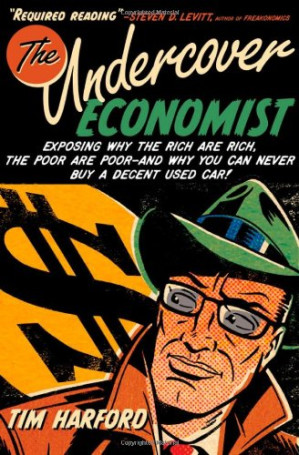Scarcity power explains why some businesses can charge high prices while others can't.
The power to raise prices comes from scarcity—and scarcity can be manufactured.

Book summary
by Tim Harford
Exposing Why the Rich Are Rich, the Poor Are Poor—and Why You Can Never Buy a Decent Used Car!
Everyday economics explained through real-world examples and stories
Topics
Read each chapter as a standalone economic detective story and immediately apply the concepts to your daily observations. Use Readever to highlight Harford's real-world examples and set reminders to practice economic thinking in your shopping, work, and investment decisions. The AI can help translate economic principles into actionable insights for your specific context.
Things to know before reading
Economist and journalist Tim Harford uses everyday examples—from coffee shops to supermarkets to traffic jams—to explain fundamental economic principles. He reveals how scarcity, power, and information shape markets and affect our daily lives in surprising ways.
Harford demonstrates that economic principles aren't abstract theories—they're powerful tools for understanding everything from your morning coffee to global trade patterns.
The power to raise prices comes from scarcity—and scarcity can be manufactured.
Markets work well when buyers and sellers have good information; they fail when information is asymmetric.
An externality is a cost or benefit that affects someone who didn't choose to incur that cost or benefit.
Ready to continue? Launch the Readever reader and keep turning pages without paying a cent.
This summary reveals the economic logic behind everyday phenomena, helping you understand why prices vary, how markets work, and what strategies businesses use to maximize profits. You'll learn to apply economic thinking to make better personal and business decisions.
Key idea 1
The power to raise prices comes from scarcity—and scarcity can be manufactured.
Businesses with scarce resources—whether prime location, unique products, or special knowledge—can charge premium prices. Understanding scarcity power helps explain why Starbucks charges more than other coffee shops and how companies create artificial scarcity.
Remember
Key idea 2
Markets work well when buyers and sellers have good information; they fail when information is asymmetric.
When one party has better information than another, markets can break down. This explains why used car markets are problematic (sellers know more than buyers) and why signaling (like education credentials) becomes important.
Remember
Key idea 3
An externality is a cost or benefit that affects someone who didn't choose to incur that cost or benefit.
When transactions affect third parties not involved in the exchange, markets may not produce optimal outcomes. Pollution is a negative externality; education creates positive externalities. Understanding externalities helps explain why some government intervention is necessary.
Remember
The Undercover Economist takes readers on a journey through the hidden economic logic of everyday life. Harford uses vivid examples—why Starbucks coffee costs so much, how supermarkets manipulate shopping behavior, why traffic jams occur—to explain core economic concepts like scarcity, market power, externalities, and information economics.
The book demonstrates that economics is not about dry statistics but about understanding human behavior and incentives. By applying economic thinking to familiar situations, Harford makes complex concepts accessible and shows how they shape our world in profound ways.
Open Readever's reader to highlight passages, ask the AI companion questions, and keep exploring without paying a cent.
Harford succeeds in making economics engaging and relevant without oversimplifying complex concepts. His journalistic background shines through in clear writing and compelling storytelling. While covering familiar economic territory, the book's strength lies in its practical applications and real-world examples that make abstract principles concrete.
Anyone curious about the economic forces shaping daily life.
Business professionals wanting to understand market dynamics.
Students looking for an engaging introduction to economics.
Consumers wanting to make more informed purchasing decisions.
Tim Harford is an economist, journalist, and broadcaster. He writes the "Undercover Economist" column for the Financial Times and presents the BBC radio series "More or Less." His ability to explain complex economic concepts in accessible language has made him one of the most popular economics communicators of his generation.
Build your personalized reading stack
Download full-length ePubs in one click with personal cloud storage.
Blend AI-guided insights with tactile note-taking to accelerate reflection.
Follow curated reading journeys tailored to your goals and time budget.
Sync highlights across devices so lessons stick beyond the page.
Sign in to Readever to keep reading with AI guidance, instant summaries, and synced notes.
The Undercover Economist demonstrates that economic principles are powerful tools for understanding the world around us. By learning to see the hidden economic logic in everyday situations, we can make better decisions as consumers, businesspeople, and citizens.
The Undercover Economist succeeds in making economics not just understandable but genuinely fascinating. By connecting abstract economic principles to concrete everyday experiences, Harford helps readers develop an "economic way of thinking" that can be applied to countless situations in business, policy, and personal life.
The book's enduring value lies in its demonstration that economics is not about complex mathematics but about understanding human behavior, incentives, and the hidden logic that shapes our world—a powerful toolkit for making sense of an increasingly complex economic landscape.
Start reading The Undercover Economist for free and unlock personalized book journeys with Readever.